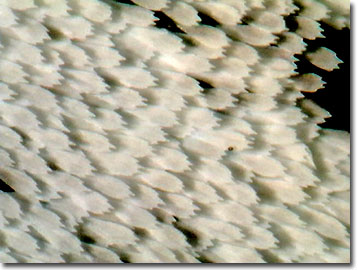Butterfly Wing Scale Digital Image Gallery
Orchard Swallowtail Butterfly
Unlike most of the members of the family Papilionidae, orchard swallowtail butterflies lack tails on their hind wings. In the larval stage, orchard swallowtails voraciously chew the leaves of economically important orange, tangerine, and lemon trees. The caterpillars are such noisy feeders that their leaf crunching sounds can be used to locate them at night.

Scientifically described as Papilio aegeus, but also known as the large citrus butterfly or orchard butterfly, these lepidopterans are commonly seen in Australian home gardens and in New Guinea feeding at flowers, such as the native lantana. Very mobile and active insects, mature orchard swallowtail butterflies continue to rapidly vibrate their wings even when pausing to eat flower nectar or sip moisture. When they do decide to rest, however, the butterflies tend to hold their wings wide-open. Due to the habitat requirements of young food plants, orchard swallowtails prefer warm, humid, and sheltered conditions, but are not territorial.
Orchard swallowtail butterflies are large and beautiful. The wing topsides of males are primarily black with white or cream crescents and a bright red spot on each hind wing. The undersides of their hind wings have fewer white markings and additional red markings with small blue crescents. Females are browner than the males and feature a white patch on their forewings and brown veins. The upper surfaces of their hind wings feature numerous red and blue crescents and spots, instead of the single spots displayed by males. In Australia, where the orchard swallowtail is one of the largest butterflies, the lepidopteran is often sold for releases at weddings, birthdays, and funerals.
When in the larval stage, orchard swallowtails are considered agricultural pests and are often treated with insecticides. Although the species cannot defend itself against such tactics, it does have methods for dealing with threats on a smaller level. The dark brown young larvae feature three white patches that help disguise them by resembling bird droppings on a leaf or stem. Later larval instars are green with white diagonal patches, but continue the bird dropping cryptic coloration. The insects can easily identify their own species, however, and older caterpillars sometimes cannibalize the younger larvae. For an added defense against other species, orchard swallowtail caterpillars evert a red pair of osmeteria, which secrete a chemical substance when they are threatened. If the chemical defense fails to deter predation attempts, the large, fleshy osmeteria draw the bite away from the caterpillar's head and vital organs.
Contributing Authors
Cynthia D. Kelly, Shannon H. Neaves, Laurence D. Zuckerman, and Michael W. Davidson - National High Magnetic Field Laboratory, 1800 East Paul Dirac Dr., The Florida State University, Tallahassee, Florida, 32310.
BACK TO THE BUTTERFLY WING SCALE IMAGE GALLERY
BACK TO THE DIGITAL IMAGE GALLERIES
Questions or comments? Send us an email.
© 1995-2025 by Michael W. Davidson and The Florida State University. All Rights Reserved. No images, graphics, software, scripts, or applets may be reproduced or used in any manner without permission from the copyright holders. Use of this website means you agree to all of the Legal Terms and Conditions set forth by the owners.
This website is maintained by our
Graphics & Web Programming Team
in collaboration with Optical Microscopy at the
National High Magnetic Field Laboratory.
Last Modification Friday, Nov 13, 2015 at 01:19 PM
Access Count Since January 21, 2003: 9343
Visit the website of our partner in introductory microscopy education:
|
|
